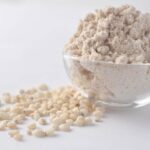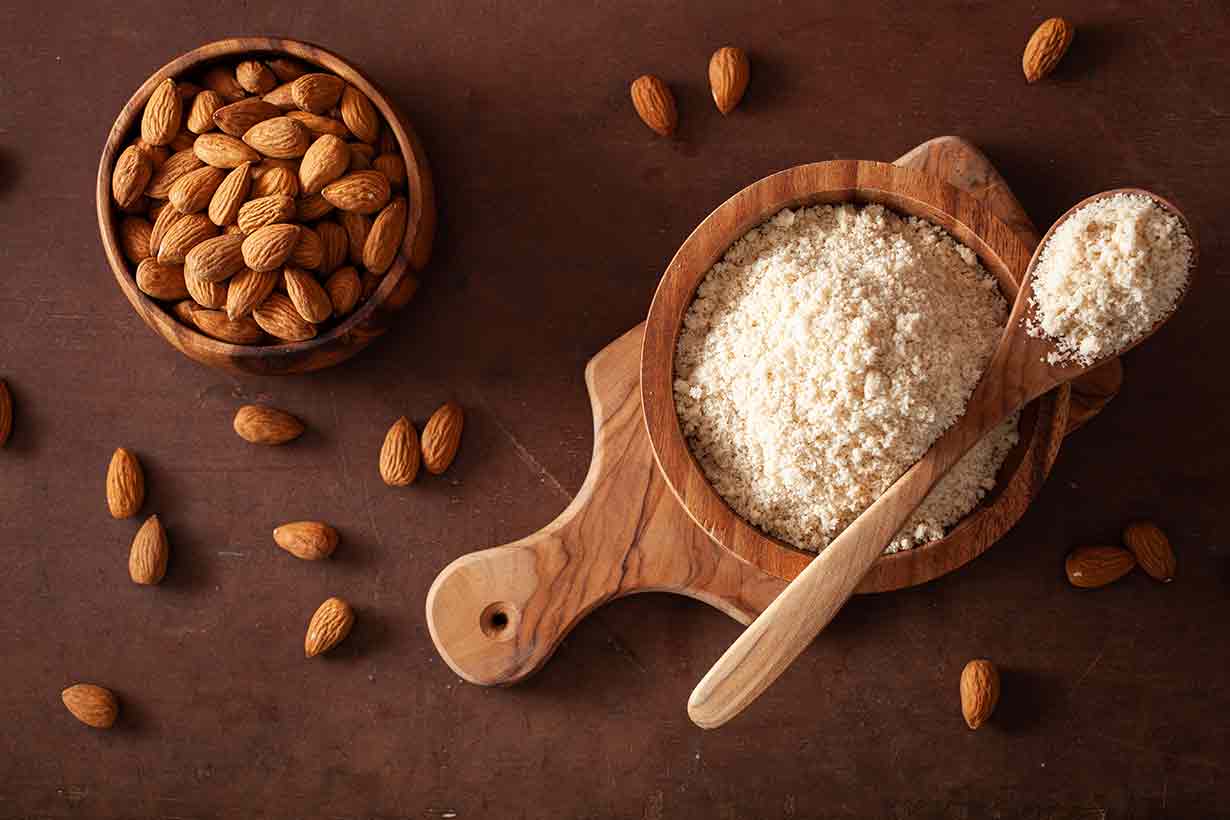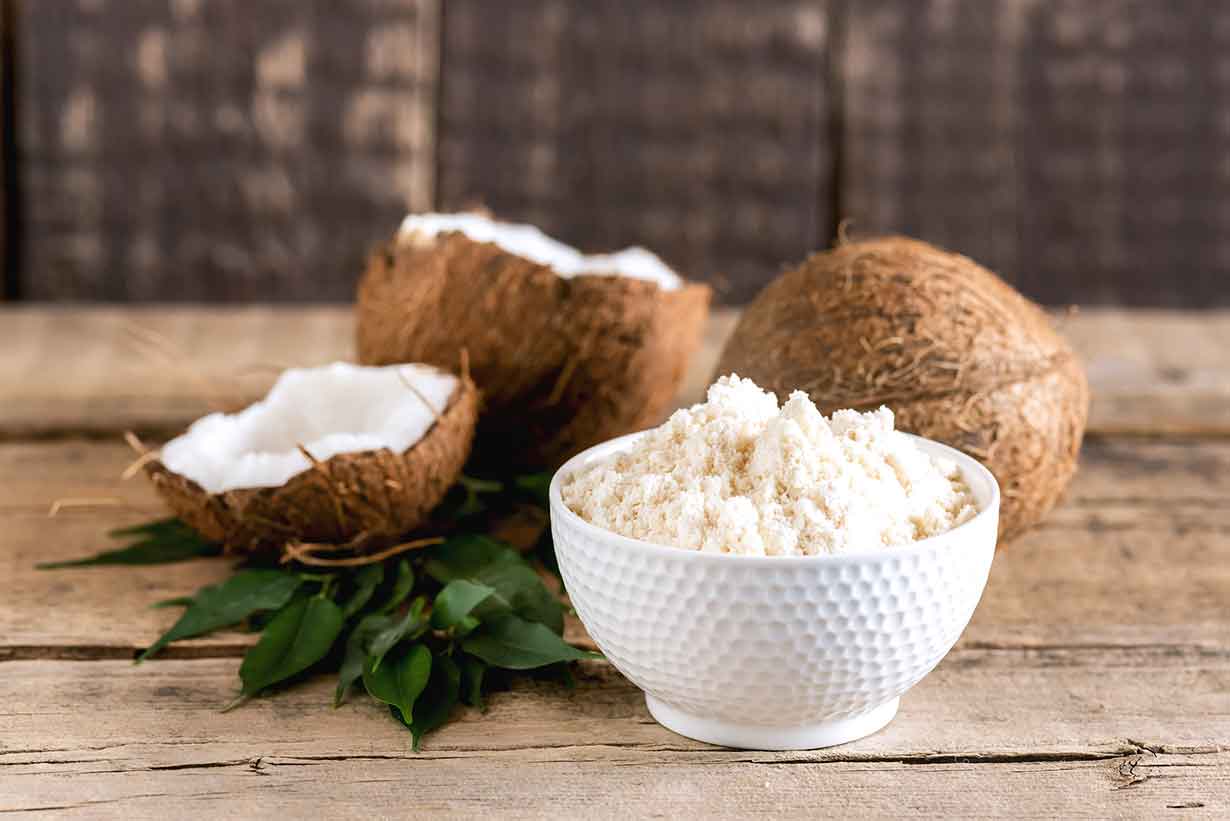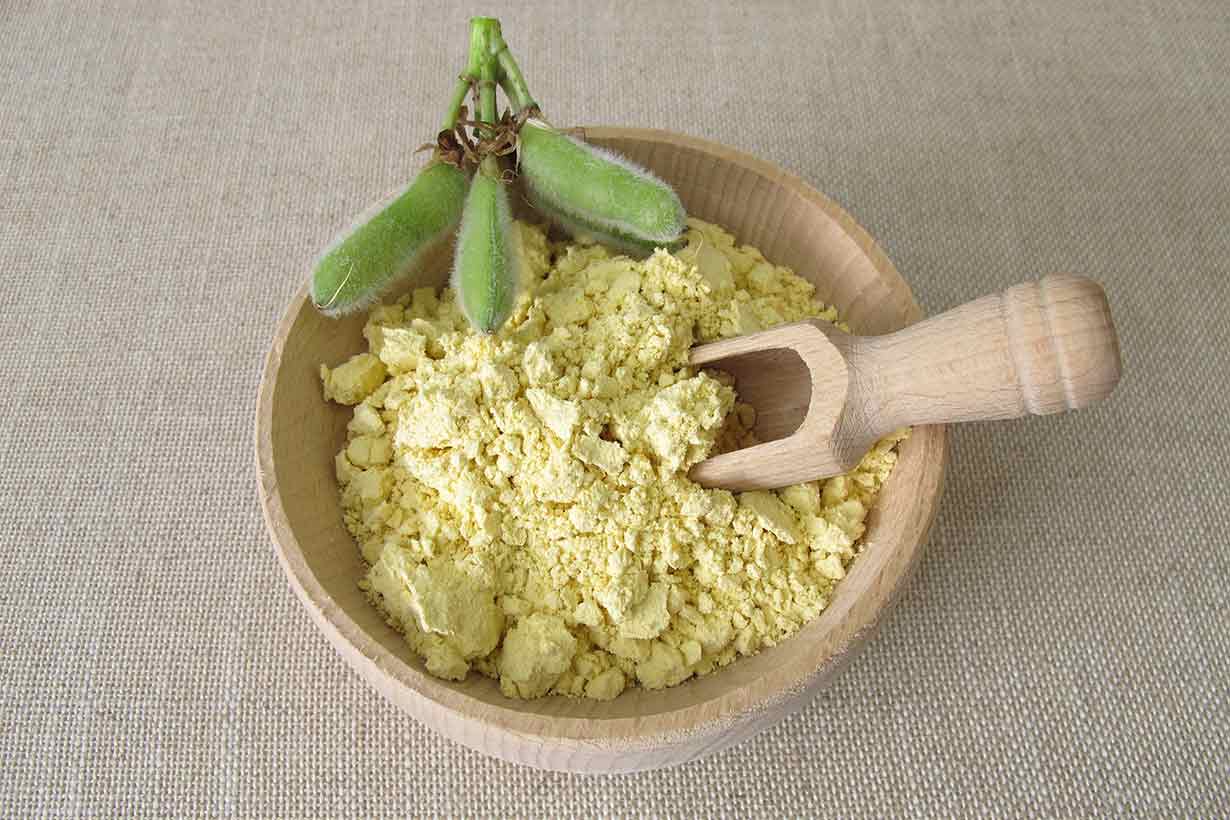For decades, wheat flour was the only kind of flour commonly used.
However, there is an abundance of choices in the present time, each with its own characteristics and nutritional properties.
This diverse range of available flours is made from a variety of foods: whole grains, refined grains, nuts, seeds, legumes, and even roots and tubers.
This article provides a summary of 37 types of flour and their nutritional values. How do they all compare?
Note: unless otherwise stated, all nutritional information is sourced from the USDA nutrition database.

1) Acorn Flour
Acorn flour is one of the lesser-known flour options, but it tastes good and can be used in a wide variety of recipes. Common foods to make with acorn flour include bread, pancakes, and porridge.
- Type of flour: nut
- Basic nutritional values per 100g: 501 calories, 54.6g carbohydrate, 30.2g fat, 7.5g protein (1)
2) Almond Flour
Almond flour has increased in popularity over recent years, and it is trendy among low-carb dieters. Compared to regular flour, it contains more fat and fewer carbohydrates.
Among its many uses, almond flour is typically used for making bread, pizza bases, and desserts.
- Type of flour: nut
- Basic nutritional values per 100g: 590 calories, 18.7g carbohydrate, 9.9g fiber, 52.5g fat, 21.4g protein (2)
Find out more about almond flour, its uses, and nutritional properties
3) Amaranth Flour
Amaranth is one of the few plants that belong to the whole grain family despite not being a true grass plant.
Flour made from amaranth has a rich and nutty taste, and it is commonly used for bread, cakes/cookies, and a flavorful thickener in sauces.
- Type of flour: whole grain
- Basic nutritional values per 100g: 400 calories, 71.4g carbohydrate, 11.4g fiber, 5.7g fat, 14.3g protein (3)
4) Arrowroot Flour
As the name may suggest, arrowroot flour is made with the starch of arrowroot, a type of tuber native to Indonesia.
Arrowroot flour is often used as a thickening agent in various dishes, and it can also give baked goods a thicker, firmer texture than wheat flour.
Nutritionally it is very high in carbohydrates with minimal amounts of fat and protein.
- Type of flour: root/tuber
- Basic nutritional values per 100g: 357 calories, 88.2g carbohydrate, 3.4g fiber, 0.1g fat, 0.3g protein (4)
5) Barley Flour
Barley is one of the true whole grains, and it is a species of grass plant.
The flour is often used alongside wheat flour in bread products.
A range of recipes features barley flour for baked goods such as cookies and pancakes.
Nutritionally, barley flour is low in fat and relatively high in fiber and protein.
- Type of flour: whole grain
- Basic nutritional values per 100g: 345 calories, 74.5g carbohydrate, 10.1g fiber, 1.6g fat, 10.5g protein (5)
6) Bread Flour
As the name might suggest, bread flour typically features in recipes to make bread.
Bread flour has a slightly higher protein content than typical wheat flour, thus gives the bread more elasticity.
- Type of flour: refined grain
- Basic nutritional values per 100g: 361 calories, 72.5g carbohydrate, 2.4g fiber, 1.7g fat, 12.0g protein (6)
7) Brown Rice Flour
Brown rice flour is ground from whole brown rice grains, and it is a somewhat popular gluten-free flour option.
This flour has a nutty flavor, and it can be an ingredient in a wide range of recipes, from bread and pizza bases to cakes and cookies.
- Type of flour: whole grain
- Basic nutritional values per 100g: 363 calories, 76.5g carbohydrate, 4.6g fiber, 2.8g fat, 7.2g protein (7)
8) Buckwheat Flour
Buckwheat flour is ground from buckwheat, a type of whole grain sometimes referred to as a ‘pseudograin.’
This is because buckwheat is botanically a herb, and it is not a true grass or cereal grain.
Buckwheat flour is used in various recipes, and buckwheat noodles (known as soba) and buckwheat porridge are prevalent.
- Type of flour: whole grain
- Basic nutritional values per 100g: 335 calories, 70.6g carbohydrate, 10.0g fiber, 3.1g fat, 12.6g protein (8)
9) Cassava Flour
Cassava flour comes from a starchy tuber called cassava, and it has a nutty and savory taste.
It is quite rich in fiber, and it enjoys popularity as a gluten-free flour option.
Cassava flour is often used alone in recipes for anything from bread, pizza crusts, and tortillas to cakes and cookies.
- Type of flour: root/tuber
- Basic nutritional values per 100g: 375 calories, 87.5g carbohydrate, 3.1g fiber, 0g fat, 3.1g protein (9)
10) Chestnut Flour
Although not quite as well-known as some other nut flours, chestnut flour is a popular option.
Chestnuts are unique among nuts for their high starch levels and slightly sweet flavor, which gives their fine flour desirable characteristics.
Known as farina dolce in Italy, the English translation of this word is ‘sweet flour’ (10).
Among its many uses, chestnut flour is most commonly used for dessert recipes like cakes, cookies, and pancakes.
The USDA nutritional database does not currently have published values for chestnut flour. However, according to My Fitness Pal, chestnut flour offers the following nutritional values (11).
- Type of flour: nut
- Basic nutritional values per 100g: 371 calories, 78.0g carbohydrate, 9.0g fiber, 3.0g fat, 6.0g protein
11) Chickpea Flour
Chickpea flour comes from garbanzo beans, more commonly known as chickpeas.
The flour has a mild and slightly sweet taste, and it is a popular gluten-free choice.
Chickpea flour can be used in the same way as regular wheat flour, such as making bread, cakes, and thickening sauces.
Nutritionally, chickpea flour has a higher fiber and protein content than many flours.
- Type of flour: legume
- Basic nutritional values per 100g: 387 calories, 57.8g carbohydrate, 10.8g fiber, 6.7g fat, 22.4g protein (12)
12) Coconut Flour
Coconut flour comes from the dried meat of the coconut, and it is an exceptionally rich source of fiber and fat.
Due to its fibrous nature, coconut flour can have a drying effect when baking, so it is important not to use too much.
Coconut flour can bind lots of different foods, act as a thickener, and increase the firmness of baked goods. It can be used in everything from pizza crusts and bread to cakes, cookies, and soups.
- Type of flour: nut
- Basic nutritional values per 100g: 400 calories, 60.0g carbohydrate, 33.3g fiber, 13.3g fat, 20.0g protein (13)
For more on coconut flour, see this guide to its nutritional properties and uses
13) Corn Flour
Corn flour contains all parts of the whole corn kernels, and for this reason, it is recognized as a whole grain.
With a pale yellow color, corn flour is used in various recipes involving bread, cakes, cookies, pancakes, and more.
Like most flours, it can also thicken different dishes, sauces, and soups.
- Type of flour: whole grain
- Basic nutritional values per 100g: 361 calories, 76.8g carbohydrate, 7.3g fiber, 3.9g fat, 6.9g protein (14)
14) Cricket Flour
Cricket flour perhaps won’t be as appealing as other flours to some people, and understandably so.
However, this flour—made from cricket insects—has increased in popularity over recent years and is seen as a sustainable, protein-rich flour option.
The flour tends to be mixed with a second flour in recipes rather than used alone, and it can be used in a wide variety of recipes.
According to the CRDB database, accessed through Cronometer, the nutritional values for cricket flour are shown below (15).
- Type of flour: insect
- Basic nutritional values per 100g: 417 calories, 8.3g carbohydrate, 8.3g fiber, 16.7g fat, 66.7g protein
15) High-Gluten Flour
High-gluten flour is a type of wheat flour, and it is similar to bread flour but with even higher protein content.
This type of flour tends to be suitable for baking recipes where a firmer, chewy texture is desired.
- Type of flour: refined grain
- Basic nutritional values per 100g: 333 calories, 70.0g carbohydrate, 3.3g fiber, 0g fat, 13.3g protein (16)
16) Kamut Flour
Kamut is a brand name for a very old strain of wheat called khorasan wheat which is often marketed as an “ancient grain.”
Kamut flour is very similar to whole wheat flour aside from slightly higher fiber content, and it is said to taste slightly different.
The flour can be used in the same way as regular whole wheat flour.
According to the NCC Nutrition Database, accessed through Cronometer, here are the nutritional properties for kamut flour (15).
- Type of flour: whole grain
- Basic nutritional values per 100g: 337 calories, 70.6g carbohydrate, 11.1g fiber, 2.1g fat, 14.5g protein
Find out more: a complete guide to the nutritional benefits of Kamut flour
17) Lupin Flour
Lupin flour is a flour made from the lupin bean, a unique type of legume.
Interestingly, lupin beans have an extremely high fiber and protein content, giving lupin flour these properties.
The flour can work in various recipes and baked goods such as bread, cakes, pancakes, pizza crusts, and more. However, it more commonly tends to be used alongside other flours.
- Type of flour: legume
- Basic nutritional values per 100g: 247 calories,40.0g carbohydrate, 36.7g fiber, 6.7g fat, 40.0g protein (17)
See the full nutritional values, potential benefits, and uses for lupin flour here
18) Millet Flour
Millet flour is produced from millet, a type of gluten-free whole grain.
While millet flour is most often used alongside other baking flours, it can also be used alone.
The flour is commonly used in bread, cake, and cookie recipes.
- Type of flour: whole grain
- Basic nutritional values per 100g: 382 calories, 75.1g carbohydrate, 3.5g fiber, 4.3g fat, 10.8g protein (18)
19) Oat Flour
Oat flour is a whole grain flour made from oats. The flour is also gluten-free, providing there has been no cross-contamination with other grains (19).
Sometimes oat flour is used alongside other flours, but it can also be used as a gram-for-gram wheat flour replacement.
- Type of flour: whole grain
- Basic nutritional values per 100g: 404 calories, 65.7g carbohydrate, 6.5g fiber, 9.1g fat, 14.7g protein (20)
20) Pastry Flour
Pastry flour is a heavily refined variety of wheat flour designed to give baked goods a lighter texture.
Compared to regular wheat flour, it has a higher carbohydrate content and lower levels of protein.
Pastry flour can be used as a direct replacement for regular wheat flour.
- Type of flour: refined grain
- Basic nutritional values per 100g: 359 calories, 77.2g carbohydrate, 1.6g fat, 8.8g protein (21)
21) Peanut Flour
Made from finely grinding peanut, this flour technically comes from a legume.
However, just as peanuts are often referred to as nuts, we’ll refer to peanut flour as nut flour here.
Peanut flour has a mildly sweet and strongly nutty taste, and it is very high in protein. It can work well as a wheat flour replacement in a range of different recipes.
- Type of flour: nut
- Basic nutritional values per 100g: 327 calories, 31.3g carbohydrate, 15.8g fiber, 21.9g fat, 33.8g protein (22)
22) Potato Flour
While it is a lesser-known variety of flour, potato flour has a mild taste and has a somewhat similar texture to wheat flour.
The flour works well as a thickener for sauces and soups, and it can also be used in baking, just like wheat flour.
Potato flour is gluten-free and it high in carbohydrates, and very low in fat.
- Type of flour: root/tuber
- Basic nutritional values per 100g: 357 calories, 83.1g carbohydrate, 5.9g fiber, 0.34g fat, 6.9g protein (23)
23) Quinoa Flour
Quinoa is another of the so-called “pseudograins” because it is not a true grass species.
The flour from quinoa is classed as a whole grain flour, and it is one of the more popular gluten-free options.
Quinoa flour has a similar texture to wheat flour and can either be used alongside or as a replacement in recipes.
Nutritionally, quinoa flour is relatively high in both protein and fiber compared to regular flour.
- Type of flour: whole grain
- Basic nutritional values per 100g: 393 calories, 64.3g carbohydrate, 7.1g fiber, 7.1g fat, 14.3g protein (24)
24) Red Lentil Flour
It’s certainly one of the lesser-known flour options, but red lentil flour is a thing, and it’s quite nutritious.
Red lentil flour is gluten-free, high in fiber and protein, and works well in many recipes.
The flour can be used for making bread, cakes, flatbreads, pancakes, and more.
According to the CRDB database, accessed through Cronometer, red lentil flour provides the following nutritional values (15):
- Type of flour: legume
- Basic nutritional values per 100g: 337 calories, 57.6g carbohydrate, 7.6g fiber, 1.7g fat, 26.0g protein
25) Rye Flour
Rye is a kind of whole grain that is closely related to wheat. The flour from rye is often used to make rye bread, a dark loaf of bread with a coarse texture.
Rye flour tends to make bakery goods with denser and heavier characteristics than wheat flour. The flour is classed as whole grain, and it contains gluten.
Nutritionally, medium rye flour is moderately high in both fiber and protein.
- Type of flour: whole grain
- Basic nutritional values per 100g: 349 calories, 75.4g carbohydrate, 11.8g fiber, 1.5g fat, 10.9g protein (25)
26) Self-raising Flour
Self-raising flour is almost the same as all-purpose wheat flour aside from its pre-inclusion of baking powder. In some countries, including the United States, self-raising flour also contains added salt.
Compared to regular wheat flour, self-raising flour has a lower protein content, which gives baked goods a lighter texture.
Self-raising flour is a popular flour option for all kinds of baking and cooking.
According to the Composition of Foods Integrated Dataset (CoFID), self-raising flour’s nutritional properties are shown below (26).
- Type of flour: refined grain
- Basic nutritional values per 100g: 353 calories, 83.6g carbohydrate, 4.0g fiber, 1.5g fat, 8.9g protein
27) Semolina Flour
Semolina is a type of wheat flour made from ground durum wheat. It has a high gluten (and thus protein) content.
One of the most common uses of semolina flour is making pasta, but it is also used in many different baking recipes.
- Type of flour: refined grain
- Basic nutritional values per 100g: 357 calories, 73.8g carbohydrate, 4.8g fiber, 1.2g fat, 11.9g protein (27)
28) Sorghum Flour
Sorghum flour is a whole grain flour option.
The flour comes from sorghum, which is a plant in the grasses family. Sorghum is gluten-free, and the flour can be used as a wheat flour replacement in some recipes.
However, since it lacks gluten, sorghum doesn’t provide the same sticky/firm texture in baked goods. For this reason, it is sometimes used alongside thickeners.
- Type of flour: whole grain
- Basic nutritional values per 100g: 359 calories, 76.6g carbohydrate, 6.6g fiber, 3.3g fat, 8.4g protein (28)
29) Sesame Flour
Sesame flour is usually made by grinding sesame seeds after they have been pressed for their oil.
Therefore, this flour is lower in fat than regular sesame seeds, and it has a nutty flavor.
Since it is a seed flour, sesame flour is gluten-free and has a higher protein and fat content than grain-based flour options.
Sesame flour can be used in numerous recipes, and it is usually used in combination with other flours.
- Type of flour: seed
- Basic nutritional values per 100g: 382 calories, 35.1g carbohydrate, 11.9g fat, 40.3g protein (29)
30) Soy Flour
Soybeans are arguably the most popular legume worldwide, and their flour is rich in fiber and protein.
Although ‘defatted’ soy flour exists, most soy flour tends to contain the whole soybean.
The flour is usually used alongside other flours, and it can be used in various baked goods and for thickening sauces and soups.
- Type of flour: legume
- Basic nutritional values per 100g: 439 calories, 30.4g carbohydrate, 9.7g fiber, 21.9g fat, 38.1g protein (30)
31) Spelt Flour
Spelt is another type of grain that shares close similarities with wheat. Flour made from this grain tends to include all parts of the grain kernel, meaning it is a whole-grain flour.
Compared to wheat flour, spelt flour contains slightly higher amounts of fiber and protein.
The flour can also be used as a direct replacement for wheat flour in recipes.
- Type of flour: whole grain
- Basic nutritional values per 100g: 367 calories, 73.3g carbohydrate, 13.3g fiber, 1.7g fat, 16.7g protein (31)
32) Sunflower Seed Flour
Sunflower seed flour is a very fine, mild-tasting flour. It is made by grinding whole sunflower seeds, usually after their oil has been extracted.
Since it is a seed flour, it is much higher in protein than grain-based flour.
Sunflower flour can be used in a similar way to almond flour and sesame flour.
- Type of flour: seed
- Basic nutritional values per 100g: 326 calories, 35.8g carbohydrate, 5.2g fiber, 1.7g fat, 48.1g protein (32)
33) Tapioca Flour
Tapioca flour is closely related to cassava flour, and both flours come from the cassava root.
However, the major difference is that tapioca flour is made solely from the starch within cassava rather than the whole root.
As a result, tapioca flour contains less fiber than cassava flour.
Tapioca flour is perhaps most famously used to make the pearl balls within bubble tea. It can also be used to make a wide variety of baked goods.
- Type of flour: root/tuber
- Basic nutritional values per 100g: 333 calories, 86.7g carbohydrate, 0g fiber, 0g fat, 0g protein (33)
34) Teff Flour
Teff flour is a gluten-free and whole-grain option made from a grain native to Africa called Teff.
This flour can be used to make a wide range of baked goods such as bread, cakes, cookies, and pancakes. However, it is usually used alongside other flours rather than alone.
- Type of flour: whole grain
- Basic nutritional values per 100g: 371 calories, 77.1g carbohydrate, 5.7g fiber, 2.9g fat, 11.4g protein (34)
35) Wheat Flour (All-Purpose Flour)
Sometimes known as all-purpose flour or white flour, regular wheat flour is refined flour that contains only the endosperm (starch) from the grain.
Despite this, it is the most popular and widely-used flour in the world.
Some reasons for this include the flour’s mild taste and its ability to add firm structure to baked goods.
As well as featuring in recipes for all baked goods, wheat flour is also commonly used to thicken sauces and soups.
- Type of flour: refined grain
- Basic nutritional values per 100g: 364 calories, 76.3g carbohydrate, 2.7g fiber, 1.0g fat, 10.3g protein (35)
36) White Rice Flour
White rice flour is a more refined alternative to brown rice flour, and it has a milder taste and lighter texture.
This flour is used in a wide variety of recipes, from baked goods to rice noodles and for thickening cooked dishes.
- Type of flour: refined grain
- Basic nutritional values per 100g: 366 calories, 80.1g carbohydrate, 2.4g fiber, 1.4g fat, 6.0g protein (36)
37) Whole Wheat Flour
Whole wheat flour includes the whole grain kernel: the bran, germ, and endosperm.
Depending on the country, the names whole wheat flour and wholemeal flour are used interchangeably.
This form of wheat flour contains a higher fiber and protein content than all-purpose flour, and it has a richer nutty and savory flavor.
It can be used in all recipes that call for wheat flour, and it will provide a slightly better nutritional profile in the finished product.
- Type of flour: whole grain
- Basic nutritional values per 100g: 332 calories, 74.5g carbohydrate, 13.1g fiber, 2.0g fat, 9.6g protein (37)
Which Type of Flour is the Best Choice?
There is no right answer for which type of flour is the “best” choice.
That depends on if one wishes to find a gluten-free flour, a high-protein option, the flour that offers the most fiber, and so on.
However, all flours provide their own unique characteristics and nutritional profiles.
The “best” flour just depends on if those characteristics meet the aim of the person using it.





